The smart behind-the-ear hearing aid market is projected to grow from USD 3,240.6 million in 2025 to USD 5,380.0 million by 2035, reflecting a steady compound annual growth rate (CAGR) of 5.2%. In the first phase, from 2025 to 2030, the market experiences gradual growth, moving from USD 2,515.0 million to USD 3,240.6 million. This early growth is driven by the increasing demand for advanced hearing solutions, such as hearing aids with Bluetooth connectivity, noise reduction, and improved sound processing. The market expands incrementally with annual values rising from USD 2,645.8 million in 2026, USD 2,783.4 million in 2027, and USD 2,928.1 million in 2028, reflecting gradual adoption.
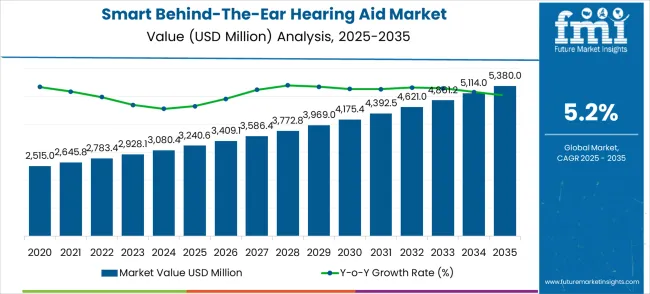
From 2030 to 2035, the market enters an accelerated growth phase, with values moving from USD 3,240.6 million in 2030 to USD 5,380.0 million by 2035. This period sees a more significant surge in demand, with values progressing from USD 3,409.1 million in 2031 to USD 3,586.4 million in 2032, and reaching USD 3,772.8 million in 2033. The increase is driven by ongoing technological advancements, such as AI-powered features, enhanced design, and better integration with personal devices. As the global population ages and more people seek hearing solutions, the market experiences robust expansion in both developed and emerging markets.
| Metric | Value |
|---|---|
| Estimated Value in (2025E) | USD 3,240.6 million |
| Forecast Value in (2035F) | USD 5,380.0 million |
| Forecast CAGR (2025 to 2035) | 5.2% |
The smart behind-the-ear hearing aid market is a growing segment driven by advancements in technology, an aging population, and rising awareness of hearing loss. In the hearing aids market, smart behind-the-ear hearing aids account for approximately 25-30% of the total market share. These devices are preferred for their comfort, discreet design, and superior sound quality, making them ideal for individuals seeking both functionality and aesthetics. In the consumer electronics market, smart hearing aids represent around 8-10%, as they integrate advanced features like Bluetooth connectivity and mobile app control, enabling users to connect seamlessly with smartphones, televisions, and other devices. This connectivity is a major driver of their appeal in the broader tech ecosystem.
In the medical devices market, smart behind-the-ear hearing aids contribute about 6-8%, reflecting the growing demand for personalized, medical-grade solutions that enhance hearing quality. These devices incorporate adaptive technologies like noise cancellation and real-time adjustments, meeting the needs of individuals with varying degrees of hearing loss. In the assistive technology market, the share of smart behind-the-ear hearing aids is around 5-7%, as they help improve the quality of life for those with hearing impairments, enabling better communication and independence. In the aging population market, these devices represent approximately 10-12%, driven by the increasing prevalence of hearing loss among older adults.
Market expansion is being supported by the increasing prevalence of hearing loss across aging populations and the corresponding demand for technologically advanced hearing solutions that can integrate with modern digital lifestyles. Modern hearing aid users are increasingly focused on devices that can provide seamless connectivity with smartphones, streaming capabilities, and personalized hearing enhancement through artificial intelligence algorithms. The proven capability of smart behind-the-ear hearing aids to deliver superior sound quality, user customization, and clinical monitoring makes them essential components of comprehensive hearing healthcare solutions.
The growing emphasis on preventive healthcare and early intervention for hearing loss is driving demand for advanced hearing technologies that can support long-term hearing health management and quality of life improvements. Industry preference for hearing solutions that combine clinical effectiveness with user-friendly technology features is creating opportunities for innovative smart hearing aid development. The rising influence of telehealth and remote patient monitoring is also contributing to increased demand for connected hearing devices that can support ongoing clinical management across different healthcare delivery models and patient populations.
The market is segmented by classification, application, and region. By classification, the market is divided into basic smart behind-the-ear hearing aid, advanced smart behind-the-ear hearing aid, and others. Based on application, the market is categorized into adults and children. Regionally, the market is divided into Asia Pacific, North America, Europe, Latin America, and Middle East & Africa.
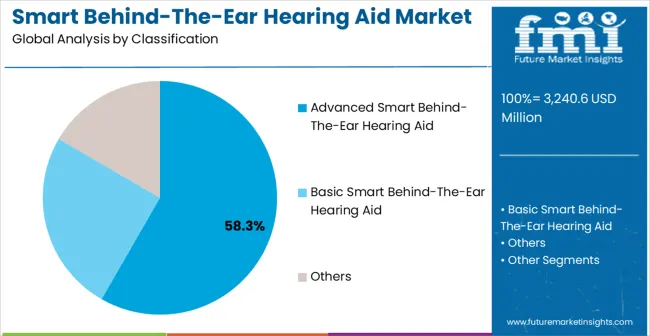
The advanced smart behind-the-ear hearing aid classification is projected to account for 58.3% of the smart behind-the-ear hearing aid market in 2025, reaffirming its position as the category's dominant technology segment. Hearing healthcare professionals increasingly recognize the superior clinical outcomes and user satisfaction provided by advanced smart features including artificial intelligence processing, adaptive noise reduction, and comprehensive connectivity options. This classification addresses the most sophisticated hearing enhancement requirements while providing essential smart technology integration.
This classification forms the foundation of most premium hearing aid prescriptions, as it represents the most technologically advanced and clinically effective approach in current hearing aid technology. Clinical research and user feedback continue to strengthen confidence in advanced smart hearing aid capabilities. With increasing recognition of the importance of personalized hearing solutions and technology integration, advanced smart devices align with both clinical best practices and user lifestyle requirements. Their comprehensive feature set across multiple hearing loss types ensures market dominance, making them the central growth driver of smart behind-the-ear hearing aid adoption.
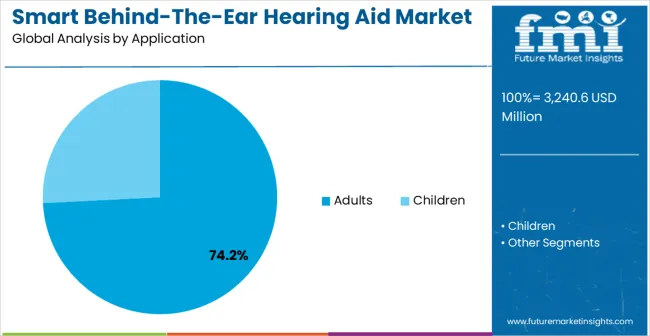
Adults are projected to represent 74.2% of smart behind-the-ear hearing aid demand in 2025, underscoring their role as the primary application driving market development. Healthcare providers recognize that adult hearing loss represents the largest patient population requiring sophisticated hearing aid technologies to address age-related hearing decline and lifestyle integration needs. Adult applications demand the most comprehensive feature sets and technology integration that smart behind-the-ear hearing aids are uniquely positioned to deliver.
The segment is supported by the rapidly aging global population requiring increasingly sophisticated hearing solutions and the growing recognition of hearing loss impact on cognitive health and quality of life. Adult users are increasingly adopting technology-enabled healthcare solutions that can provide enhanced functionality and clinical monitoring capabilities. As understanding of adult hearing healthcare needs advances, smart hearing aid applications will continue to serve as the primary market driver, reinforcing their essential position within the hearing healthcare technology market.
The smart behind-the-ear hearing aid market is advancing rapidly due to increasing prevalence of hearing loss and growing adoption of digital health technologies. The market faces challenges including high device costs, insurance coverage limitations, and user adaptation requirements for advanced technology features. Innovation in artificial intelligence integration and wireless connectivity continue to influence product development and market expansion patterns.
The growing adoption of telehealth services is enabling more sophisticated hearing aid management and remote clinical support capabilities. Advanced telehealth platforms offer comprehensive remote adjustment capabilities, including real-time audiogram analysis and personalized programming, that are particularly important for ongoing hearing aid optimization. Remote monitoring systems provide access to continuous hearing health assessment and proactive intervention strategies that can optimize long-term outcomes.
Modern hearing aid companies are incorporating AI-powered sound processing, adaptive noise reduction algorithms, and personalized learning systems to enhance smart behind-the-ear hearing aid performance and user experience. These technologies improve speech recognition, enable automatic environment adaptation, and provide enhanced customization throughout daily use patterns. Advanced AI integration also enables predictive maintenance and improved clinical decision support characteristics.
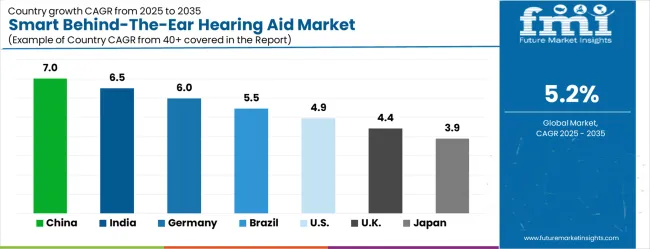
| Country | CAGR (2025-2035) |
|---|---|
| China | 7.0% |
| India | 6.5% |
| Germany | 6.0% |
| Brazil | 5.5% |
| USA | 4.9% |
| UK | 4.4% |
| Japan | 3.9% |
The smart behind-the-ear hearing aid market is experiencing robust growth globally, with China leading at a 7.0% CAGR through 2035, driven by rapidly aging population, increasing healthcare awareness, and growing adoption of advanced medical technologies. India follows at 6.5%, supported by expanding healthcare infrastructure, rising hearing loss prevalence, and increasing access to hearing healthcare services. Germany shows growth at 6.0%, emphasizing precision healthcare delivery and comprehensive hearing aid coverage systems. Brazil records 5.5% growth, focusing on expanding healthcare access and growing awareness of hearing health importance. The USA shows 4.9% growth, representing mature market dynamics with continued innovation in hearing aid technologies.
The report covers an in-depth analysis of 40+ countries with top-performing countries highlighted below.
Revenue from smart behind-the-ear hearing aids in China is projected to exhibit strong growth with a CAGR of 7.0% through 2035, driven by rapidly aging population demographics and comprehensive government support for healthcare technology advancement. The country's expanding healthcare infrastructure and increasing capabilities in digital health technologies are creating substantial opportunities for advanced hearing aid adoption. Major domestic and international hearing aid companies are establishing comprehensive distribution and service networks to serve the growing hearing healthcare market.
The smart behind-the-ear hearing aid market in India is expanding at a CAGR of 6.5%, supported by growing healthcare accessibility, increasing awareness of hearing health importance, and expanding availability of advanced hearing aid technologies. The country's large population base and increasing recognition of hearing loss impact are driving demand for sophisticated hearing solutions. International hearing aid companies and domestic healthcare providers are establishing partnerships to serve the growing demand for hearing healthcare services.
Demand for smart behind-the-ear hearing aids in Germany is projected to expand at a CAGR of 6.0%, supported by the country's comprehensive healthcare system and established hearing aid coverage programs. German healthcare providers and audiology professionals consistently utilize advanced hearing aid technologies through systematic clinical protocols and established reimbursement frameworks. The market is characterized by clinical excellence, comprehensive patient care, and established relationships between healthcare providers and hearing aid manufacturers.
The smart behind-the-ear hearing aid market in Brazil is projected to grow at a CAGR of 5.5% through 2035, driven by healthcare system expansion, increasing awareness of hearing health importance, and growing access to audiology services. Brazilian healthcare providers are increasingly adopting advanced hearing aid technologies to support comprehensive hearing healthcare delivery and patient quality of life improvements.
Revenue from smart behind-the-ear hearing aids in the USA is anticipated to expand at a CAGR of 4.9%, supported by established hearing healthcare infrastructure, continued innovation in hearing aid technologies, and comprehensive audiology practice networks. American hearing aid companies and healthcare providers consistently advance smart hearing aid adoption through established clinical protocols and technology integration programs.
Sale of smart behind-the-ear hearing aids in the UK is growing at a CAGR of 4.4% through 2035, supported by National Health Service hearing aid programs and comprehensive clinical guidelines for hearing healthcare delivery. British healthcare providers emphasize evidence-based hearing aid utilization within integrated care frameworks that prioritize patient outcomes and cost-effectiveness.
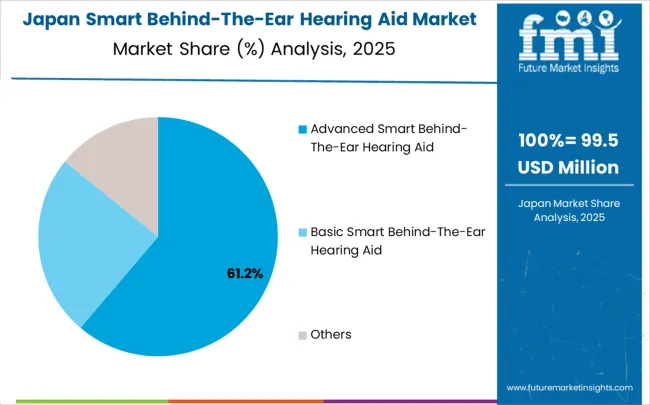
Demand for smart behind-the-ear hearing aids in Japan is expanding at a CAGR of 3.9% through 2035, supported by the country's advanced healthcare system and comprehensive approach to aging population healthcare needs. Japanese hearing aid manufacturers and healthcare providers emphasize technology-driven hearing solutions within established frameworks that prioritize clinical effectiveness and user satisfaction.
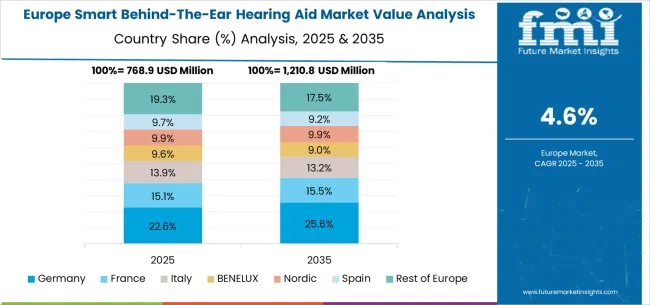
The smart behind-the-ear hearing aid market in Europe is projected to expand steadily through 2035, supported by increasing adoption of digital hearing technologies, rising awareness of hearing health importance, and ongoing innovation in smart hearing aid capabilities. Germany will continue to lead the regional market, accounting for 28.9% in 2025 and rising to 29.7% by 2035, supported by comprehensive healthcare coverage, advanced audiology practices, and established hearing aid reimbursement systems. The United Kingdom follows with 19.4% in 2025, increasing to 19.8% by 2035, driven by NHS hearing aid programs, clinical excellence initiatives, and expanding digital health integration.
France holds 16.7% in 2025, edging up to 17.1% by 2035 as healthcare providers expand digital hearing aid adoption and demand grows for advanced hearing technologies. Italy contributes 13.2% in 2025, remaining stable at 13.4% by 2035, supported by aging population healthcare needs and growing hearing health awareness. Spain represents 9.8% in 2025, moving upward to 10.0% by 2035, underpinned by expanding healthcare access and increasing investment in hearing healthcare services.
Nordic countries together account for 7.1% in 2025, maintaining their position at 7.2% by 2035, supported by advanced healthcare systems and early adoption of innovative hearing technologies. The Rest of Europe represents 4.9% in 2025, declining slightly to 2.8% by 2035, as larger markets capture greater investment focus and established healthcare infrastructure advantages.
The smart behind-the-ear hearing aid market is characterized by competition among established hearing aid manufacturers, technology-focused companies, and innovative digital health firms. Companies are investing in artificial intelligence development, wireless connectivity enhancement, strategic partnerships, and clinical research to deliver high-performance, user-friendly, and clinically effective hearing solutions. Technology development, clinical validation, and market access strategies are central to strengthening competitive advantages and market presence.
Sonova leads the market with significant expertise in hearing aid technology development, offering comprehensive smart behind-the-ear solutions with focus on clinical excellence and technology integration. Demant provides established hearing healthcare capabilities with emphasis on advanced digital signal processing and connectivity features. GN Hearing focuses on innovative hearing aid technologies with comprehensive smart features and user experience optimization. Starkey Hearing Technologies delivers advanced hearing aid solutions with strong focus on artificial intelligence integration and health monitoring capabilities.
WS Audiology operates with focus on comprehensive hearing aid manufacturing and global market reach. iFLYTEK provides artificial intelligence technologies with emphasis on speech processing and smart device integration. Bose leverages consumer electronics expertise to develop innovative hearing enhancement solutions. Rion specializes in professional audiology equipment and hearing aid technologies. Eargo, ExSilent, Alango, Hearzap, Jinghao Medical Technology, and BOIN Hearing Technology provide diverse technological approaches and market access strategies to enhance overall market development and hearing healthcare accessibility.
| Items | Values |
|---|---|
| Quantitative Units (2025) | USD 3,240.6 million |
| Classification | Basic Smart Behind-The-Ear Hearing Aid, Advanced Smart Behind-The-Ear Hearing Aid, Others |
| Application | Adults, Children |
| Regions Covered | Asia Pacific, North America, Europe, Latin America, Middle East & Africa |
| Countries Covered | China, India, Germany, Brazil, United States, United Kingdom, Japan and 40+ countries |
| Key Companies Profiled | Sonova, Demant, GN Hearing, Starkey Hearing Technologies, WS Audiology, iFLYTEK, Bose, Rion, Eargo, ExSilent, Alango, Hearzap, Jinghao Medical Technology, BOIN Hearing Technology |
| Additional Attributes | Dollar sales by device type and application, regional adoption trends, competitive landscape, healthcare provider partnerships, integration with digital health platforms, innovations in AI and connectivity features, clinical outcome analysis, and user experience optimization strategies |
The global smart behind-the-ear hearing aid market is estimated to be valued at USD 3,240.6 million in 2025.
The market size for the smart behind-the-ear hearing aid market is projected to reach USD 5,380.0 million by 2035.
The smart behind-the-ear hearing aid market is expected to grow at a 5.2% CAGR between 2025 and 2035.
The key product types in smart behind-the-ear hearing aid market are advanced smart behind-the-ear hearing aid, basic smart behind-the-ear hearing aid and others.
In terms of application, adults segment to command 74.2% share in the smart behind-the-ear hearing aid market in 2025.






Our Research Products

The "Full Research Suite" delivers actionable market intel, deep dives on markets or technologies, so clients act faster, cut risk, and unlock growth.

The Leaderboard benchmarks and ranks top vendors, classifying them as Established Leaders, Leading Challengers, or Disruptors & Challengers.

Locates where complements amplify value and substitutes erode it, forecasting net impact by horizon

We deliver granular, decision-grade intel: market sizing, 5-year forecasts, pricing, adoption, usage, revenue, and operational KPIs—plus competitor tracking, regulation, and value chains—across 60 countries broadly.

Spot the shifts before they hit your P&L. We track inflection points, adoption curves, pricing moves, and ecosystem plays to show where demand is heading, why it is changing, and what to do next across high-growth markets and disruptive tech

Real-time reads of user behavior. We track shifting priorities, perceptions of today’s and next-gen services, and provider experience, then pace how fast tech moves from trial to adoption, blending buyer, consumer, and channel inputs with social signals (#WhySwitch, #UX).

Partner with our analyst team to build a custom report designed around your business priorities. From analysing market trends to assessing competitors or crafting bespoke datasets, we tailor insights to your needs.
Supplier Intelligence
Discovery & Profiling
Capacity & Footprint
Performance & Risk
Compliance & Governance
Commercial Readiness
Who Supplies Whom
Scorecards & Shortlists
Playbooks & Docs
Category Intelligence
Definition & Scope
Demand & Use Cases
Cost Drivers
Market Structure
Supply Chain Map
Trade & Policy
Operating Norms
Deliverables
Buyer Intelligence
Account Basics
Spend & Scope
Procurement Model
Vendor Requirements
Terms & Policies
Entry Strategy
Pain Points & Triggers
Outputs
Pricing Analysis
Benchmarks
Trends
Should-Cost
Indexation
Landed Cost
Commercial Terms
Deliverables
Brand Analysis
Positioning & Value Prop
Share & Presence
Customer Evidence
Go-to-Market
Digital & Reputation
Compliance & Trust
KPIs & Gaps
Outputs
Full Research Suite comprises of:
Market outlook & trends analysis
Interviews & case studies
Strategic recommendations
Vendor profiles & capabilities analysis
5-year forecasts
8 regions and 60+ country-level data splits
Market segment data splits
12 months of continuous data updates
DELIVERED AS:
PDF EXCEL ONLINE
Smart School Bus Platform Market Size and Share Forecast Outlook 2025 to 2035
Smart Home Wireless Smoke Detector Market Size and Share Forecast Outlook 2025 to 2035
Smart Bus Platform Market Size and Share Forecast Outlook 2025 to 2035
Smart Vision Processing Chips Market Size and Share Forecast Outlook 2025 to 2035
Smart Touch Screen Scale Market Size and Share Forecast Outlook 2025 to 2035
Smart Magnetic Drive Conveyor System Market Size and Share Forecast Outlook 2025 to 2035
Smart Wheelchair market Size and Share Forecast Outlook 2025 to 2035
Smart Mining Technologies Market Size and Share Forecast Outlook 2025 to 2035
Smart Parking Market Size and Share Forecast Outlook 2025 to 2035
Smart Digital Valve Positioner Market Forecast and Outlook 2025 to 2035
Smart Card IC Market Size and Share Forecast Outlook 2025 to 2035
Smart-Tag Inlay Inserters Market Analysis - Size and Share Forecast Outlook 2025 to 2035
Smart TV Market Forecast and Outlook 2025 to 2035
Smart/AI Toy Market Size and Share Forecast Outlook 2025 to 2035
Smart Locks Market Size and Share Forecast Outlook 2025 to 2035
Smart Sprinkler Controller Market Size and Share Forecast Outlook 2025 to 2035
Smart Indoor Gardening System Market Size and Share Forecast Outlook 2025 to 2035
Smart Building Delivery Robot Market Size and Share Forecast Outlook 2025 to 2035
Smart Watch Market Size and Share Forecast Outlook 2025 to 2035
Smart Label Market Size and Share Forecast Outlook 2025 to 2035

Thank you!
You will receive an email from our Business Development Manager. Please be sure to check your SPAM/JUNK folder too.
Chat With
MaRIA